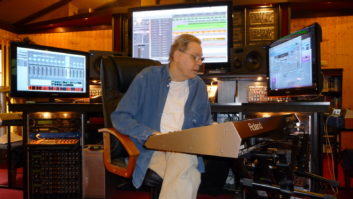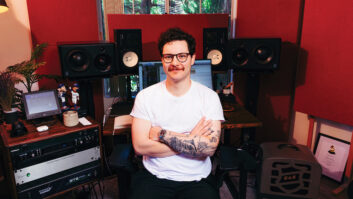Jon Regen’s Stop Time was sparked at a London party where the singer/songwriter found himself jamming with actor Jeremy Irons—Regen on piano and Irons on cello—in a distinctly New Orleansy kind of vibe.
Relationship changes, influence from New Orleans, a musical inspiration as producer and a new band add up to make Jon Regen’s latest work, Stop Time, a departure from previous releases.
Regen soon paired with producer Mitchell Froom (Crowded House, Paul McCartney) and began piecing together material for the new album. The title track is a The Picture of Dorian Gray-esque tale of a man who becomes dismayed at the passing of his youth, all cast within Regen’s soulful delivery of vocals, piano and artful lyrics. With the help of Froom, Stop Time sees Regen backed up by Elvis Costello and the Imposters’ members Davey Faragher and Pete Thomas. Pro Sound News caught up with Regen amid his usual busy schedule of live performances.
ON RAMPING UP:
My last record came out in 2012. It was called Revolution, and pretty much a homespun affair. As far as the production was concerned, there were a lot of instrumental overdubs and a lot of vocal overdubs—it was a year-and-a-half in the making. After I toured that record and it was coming to the end of its cycle, I didn’t really know what I was going to do next. Around this time, I had gotten engaged to the woman who is now my wife, so I was experiencing a pretty upbeat period in my life. My last couple records had been breakup oriented, kind of melancholy singer- songwriter in style, so this led to me writing different kinds of songs. I would write on a legal pad, I would write emails to myself, whatever. I took the opportunity to get really lost in the process. One night, I went to a party in London where I bumped into the actor Jeremy Irons. We started jamming together and it turned into this bluesy New Orleans thing—this started an idea rolling in my mind. I came home and sort of married the New Orleans vibe that we had come up with to a set of lyrics that I had written about a guy who stares at himself in the mirror and sees his youth fading away. That song became the title track of the album, called “Stop Time.”
ON RECRUITING MITCHELL FROOM:
I have so many of Mitchell Froom’s records. Like most people I’m sure, he made the soundtrack to my life. When I was 16 years old, I got my driver’s license, and I had that first Crowded House record on in my car. I reached out to Mitchell and we began this daily dialog about my record. He had very strong ideas about what direction it should be, and it was about 180 degrees away from where I thought the record was going to go. For example, I thought it was going to be a ‘big record’— anthemic along the lines of Bruce Springsteen and Bruce Hornsby rock piano tunes. But Mitchell said, ‘You sing like Frank Sinatra and have this great swinging in your piano playing. Why would you want to clutter up a record with tons of instruments and tons of vocal overdubs?’ He wanted me to highlight my singing, songwriting and piano playing. He paired it down to solo piano and vocal songs. My record label loved it.
ON TRUSTING YOUR PRODUCER:
I had a very hard time arguing with anything Mitchell had to say. In a way, it was very comforting to not have to overthink any choices that were made in the process. This guy has such an impeccable record and is very opinionated—but not in an offensive way. Also, he was very measured in how he wanted these songs to go down: We did a ton of preproduction work since we didn’t have a lot of time in the studio. Budget-wise, we were forced us to be very compact in the way we executed. I was going on tour for 36 days in Europe, and before I went, Mitchell had me cut the songs I had written into my Pro Tools system through my Apogee Symphony interface so he would be able to work on the songs. By the time I came back, he played me fully realized demos of a lot of these songs, with bass and drums. This was really inspiring.
ON SONICS:
Mitchell’s idea from the start was that he wanted to put me with a band that is so good that it sounds like you have been playing together forever. He chose Davey Faragher and Pete Thomas from Elvis Costello and the Imposters, so you can’t argue with his band choice. Then I think everything that was done around that core trio was made to bring out elements of the song and add atmosphere, without distracting from the song. Our gear choices were pretty simple at the core. I played a grand piano through a spectacular Neumann U 47 that I bought from John Porter years ago that once belonged to John Lennon. I brought this mic out to Mitchell’s studio and his engineer David Boucher said, ‘That sounds like a great microphone—let’s use it.’
ON AMALGAMATING JAZZ AND POP:
I came up as a straight-ahead jazz piano player, and then around 2003 and 2004, I began writing pop songs and trying to combine the freedom of jazz with the heart of two-minute pop songs. Since 2004, that has kind of been my goal as a pianist—to meld these two worlds together. My piano playing has definitely evolved, yet remains firmly rooted in both worlds. I am a guy that has never really sat down and copied anybody—so any of my influences just come from absorbing and loving the music I’ve listened to over the years. So far, it is incredible seeing people react to my new record. They see all the optimism and the positivity in it, which is a signal of where I am in my life. If that is the reaction that listeners are getting, then mission accomplished.







